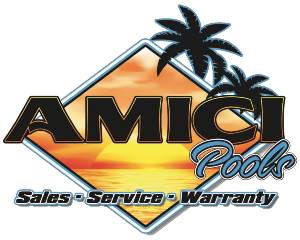Beneath the inviting surface of a sparkling pool lies a complex ecosystem that demands serious and regular maintenance. The secret to a safe and enjoyable swimming experience lies in maintaining the proper pool chemical balance. This article explores the crucial aspects of pool chemistry, equipping you with the knowledge to sustain a healthy pool environment for worry-free enjoyment.
The Players on the Field: Key Pool Chemicals
 Sanitizer: The primary function of a sanitizer is to kill bacteria and other harmful microorganisms that can cause swimmer illness. Chlorine and bromine are the most common sanitizing options for residential pools.
Sanitizer: The primary function of a sanitizer is to kill bacteria and other harmful microorganisms that can cause swimmer illness. Chlorine and bromine are the most common sanitizing options for residential pools.- Chlorine: Available in various forms (granules, tablets, liquid), chlorine is a powerful disinfectant that effectively kills bacteria, algae, and viruses. However, it can be harsh on skin and eyes, especially at high levels.
- Bromine: Gentler on skin and eyes than chlorine, bromine offers a longer-lasting residual effect. However, it is generally more expensive than chlorine and requires slightly different balancing considerations.
- pH Level: Measured on a scale of 0 (highly acidic) to 14 (highly basic), the pH level indicates the acidity or alkalinity of your pool water. The ideal pH range for a pool is 7.2 – 7.8. Water outside this range can be:
- Too acidic (low pH): Corrosive to pool equipment and irritate swimmers’ eyes.
- Too basic (high pH): Reduce the effectiveness of chlorine, leading to cloudy water, algae growth, and skin irritation.
- Alkalinity: Alkalinity acts as a buffer, helping to resist changes in pH levels. Proper alkalinity (80-120 ppm) is crucial for maintaining a stable pH and ensuring the effectiveness of your sanitizer. Low alkalinity allows the pH to fluctuate wildly, while high alkalinity can cause cloudy water and scaling on pool surfaces.
- Free Chlorine/Bromine Residual: This refers to the amount of available sanitizer remaining in your pool water to combat bacteria and algae growth. The ideal free chlorine level is 1-3 ppm, while the ideal free bromine level is 3-5 ppm. Maintaining a consistent residual ensures continuous disinfection.
The Balancing Act: Maintaining Optimal Levels
- Testing Regularly: The key to maintaining proper chemical balance is to test your pool water regularly. Use a reliable pool test kit to measure pH, free chlorine/bromine residual, and alkalinity at least once a week, and more often during periods of heavy pool use or high temperatures.
- Adjusting Levels: Based on your test results, you may need to adjust certain chemical levels:
- Raising pH: Use a pH increaser (soda ash) to raise a low pH level. Add the recommended amount gradually and retest the water after waiting for the product to circulate.
- Lowering pH: Use a pH decreaser (muriatic acid) to lower a high pH level. Exercise extreme caution when handling muriatic acid, as it is a strong acid that can cause skin and eye burns. It is important to always use personal protective equipment (PPE) when handling this product.
- Raising Alkalinity: Use baking soda to raise low alkalinity levels.
- Lowering Alkalinity: There are limited options for directly lowering alkalinity. In extreme cases, partial draining and refilling of your pool may be necessary.
- Increasing Sanitizer Level: If the free chlorine or bromine level is too low, add the appropriate form of sanitizer (chlorine tablets, bromine granules, etc.) according to the manufacturer’s instructions and retest the water after proper circulation.
Beyond the Basics: Additional Considerations
- Shock Treatment: Regularly shocking your pool with a chlorine shock or bromine shock helps to eliminate combined chlorine/bromine, a byproduct of sanitizer use that can contribute to unpleasant odors and eye irritation. Shock treatment also helps to destroy any persistent algae or bacteria not eliminated by the daily chlorine/bromine residual.
- Cyanuric Acid (Stabilizer): Cyanuric acid, commonly referred to as pool stabilizer, helps prevent chlorine from degrading too rapidly in sunlight. However, high levels of cyanuric acid can reduce the effectiveness of chlorine. If your cyanuric acid level is too high, you may need to partially drain and refill your pool.
- Pool Enzymes: Adding pool enzymes can help break down organic matter like leaves, hair, and body oils, reducing the workload on your filter and sanitizer.
Safety First: Handling Pool Chemicals Safely
Pool chemicals can be dangerous if mishandled. Here are some important safety tips to keep in mind:
- Always read and follow the manufacturer’s instructions carefully before using any pool chemical.
- Wear appropriate personal protective equipment (PPE) such as gloves, goggles, and long sleeves when handling chemicals.
- Never mix chemicals together directly. Add chemicals to the pool water separately, waiting at least 15 minutes between adding different products.
- Keep pool chemicals in a cool, dry area, safely out of reach of children and pets. Store chemicals in their original containers and never reuse empty chemical containers for other purposes.
- Dispose of empty chemical containers properly. Do not pour leftover chemicals down the drain or onto the ground. Many communities have specific disposal procedures for hazardous waste.
- In case of accidental contact with pool chemicals:
- Rinse the affected area with clean water for a minimum of 15 minutes.
- If chemicals get in your eyes, seek immediate medical attention.
- If chemicals are ingested, call the Poison Control Center immediately.
When you understand pool chemical balancing and follow these safety guidelines, you can maintain a clean, healthy, and inviting pool environment. Regular testing, proper chemical adjustments, and responsible handling practices ensure a safe and enjoyable swimming experience for everyone. With a little knowledge and effort, you can transform your backyard into a sparkling oasis, ready for endless summer fun!
